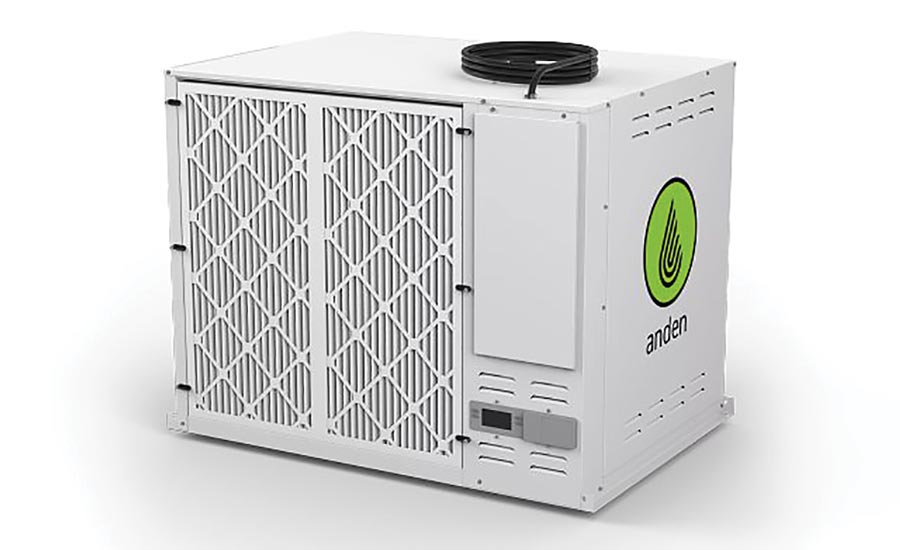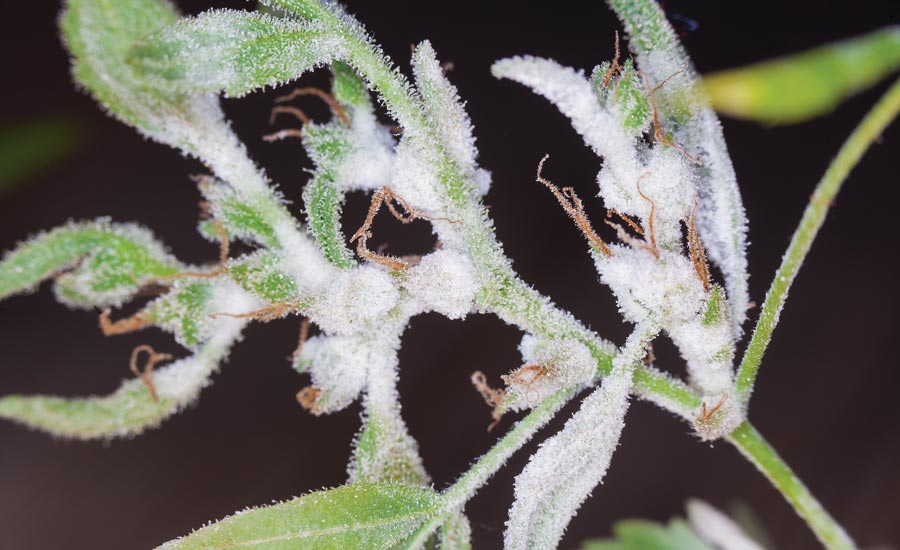HVAC for Indoor Cannabis Grow Facilities
Dehumidification Plays a Crucial Role in Cannabis Crop Production
Maintaining the right levels keeps away threats, improves products
Grow rooms are a prominent example of the potential and the challenges of indoor agriculture. They attempt to replicate the best environments for growing marijuana using a combination of lighting, hydroponics, and HVAC. Dehumidification plays a large and crucial role in this process.
Randy Lenz, applications engineer for Anden, a provider of commercial-grade environmental controls that targets the grow industry, said marijuana grows well in certain environments such as the Emerald Triangle in Northern California or the mountainsides of Afghanistan. As demand increases, however, those areas aren’t enough. They only produce one crop a year and are subject to the same uncertainty as all other outdoor farming.

Photo courtesy of Anden
FIELD SPECIFIC FOCUS: Most grow rooms use standalone dehumidifiers like this one from Anden, a branch of Research Products.
That’s where grow rooms come into play. They can be built anywhere and produce year-round. They also improve the quality of the end product.
“The more tightly you can control the environment, the better the product you can get,” Lenz said.
The term “grow room” actually refers to a facility that is usually divided into four parts. The first houses seedlings or clones. Then there is a room for the more mature, bulkier plants and sometimes the clone mother.
Bud Room Requires The Most Control
Next comes the bud room. This is the area that requires the most dehumidification, Lenz said. The plants uptake tremendous amounts of water and transpire large amounts as a result. The water contains nutrients, so the growers want the plants to take in as much as possible. That’s one reason for controlling the humidity. They want the plants consuming the water provided, not the water in the air. Too much water can stress the plants, which reduces the yield.

Photo courtesy of Oleg Malyshev via Getty
CONTROL IS CRITICAL: If humidity levels in a grow room are too high, organic substances like powdery mildew can grow on cannabis buds and ruin them.
In order to replicate sunlight, the bud rooms use intense lighting that is on for 12 hours a day and then off for 12 hours. Humidity increases when temperatures drop. Lenz said the humidifiers do more work when the lights are off, pulling moisture from the air and blowing out dry air.
“We do the majority of the work at ‘night’ and the a/c supplements that, and during the ‘day,’ the a/c does most of the work and we supplement the a/c,” Lenz said.
The other main reason to carefully control the humidity is to prevent contamination of the buds. Organic substances, such as molds, can grow in the buds if humidity levels become too high. The worst of these is powdery mildew. Cannabis plants contaminated by powdery mildew cannot be sold to consumers.
The dry room is the final stage, and this requires the most dehumidification. Growers distinguish their product by controlling factors such as flavor and strength. They do this through a combination of nutrients, light, and CO2. Some growers also have techniques to change the color of some plants for “better jar appeal,” Lenz said. This carries its own humidification requirements.
Different Growers, Different Needs
Daniel Kerr, marketing manager for Quest Climate, said creating the proper dehumidification solution for a grow room requires understanding a customer’s lighting strategy and what kinds of nutrients they use. Different customers have different needs. Like craft brewers, small growers want a distinct product. Large growers, like other mass producers, want consistency. Medical marijuana growers have the greatest needs because of tight regulations, just like a pharmaceutical producer.
Craft licenses are also seeing more regulation, said Mike Lee, president of Northern Weathermakers, an HVAC firm located in Northbrook, Illinois. This includes the type of HVAC equipment they have to use. Lee, who has worked on many grow rooms, said the ideal system would have hot and chilled water components in order to really dial in the temperature and reduce humidity. Some small operations just have an RTU with hot gas reheat to help control the humidity. A majority of grow rooms use standalone dehumidifiers.
That’s the main product for Anden. The company is a division of Research Products Corp.
“Research Products has been producing innovation for emerging industries since 1938,” Lenz said. “We invented sun gel. The flower cooler. Folding window shades. This is simply the next innovation developed by Research Products.”
Quest got into this segment the opposite way. Quest originally developed dehumidification products for indoor lettuce farmers, and these were adapted by small growers. Once company executives saw the potential, they started to pursue larger growers, Kerr said. They even found ways to convert existing solutions, such as an HVAC/dehumidifier combination designed for indoor pools, to the needs of cannabis growers.
A Maturing Market
Although they offer different approaches, both companies have proven track records. This isn’t the case with every company providing dehumidification solutions to cannabis growers, Lee said. Many are unproven and make claims that sound good but are impractical.
“They’re just jumping into the market because they see a growth area,” Lee said.
Plenty of HVAC contractors are also attracted to the industry’s growth. Lenz said they need to fully understand the special requirements of these facilities. The HVAC requirements alone are pretty shocking. Lenz said a 2,200-square-foot room can require up to 20 tons of cooling.
A common mistake would be providing that tonnage with one unit. Lenz said it’s better to use two 10-ton units and even better to use four 5-ton units. This kind of redundancy means the crop won’t be damaged if a unit needs service, as the remaining units will compensate and continue to control temperature. The growers can take other steps, such as lowering the light level, to offset the problem until an HVAC contractor can get out to fix it.
“The commercial HVAC contractors are used to providing cooling solutions for hospitals, schools, and restaurants,” Lenz said. “But they’re not as familiar with cannabis cultivation.
“Contractor understanding of cannabis cultivation will continue to develop, and it’s important for growers to make the right decisions up front when it comes to grow room design, set up, and their environmental controls to maximize predictability, efficiency, and growth.”
The market will continue to grow, as more states are legalizing marijuana and national legislation seems likely. Lee said the industry used to consist of true believers. Now, it’s a business. And like any business, growers expect results. This makes it more important than ever for HVAC contractors to understand the role of dehumidification.
Ted Craig, is the business management editor for The ACHR News. He covers areas such as marketing, back office operations, and regulation.








